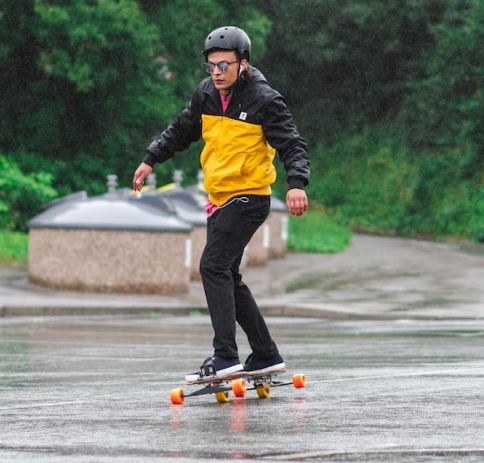Skateboarding is an exhilarating sport that brings joy to many enthusiasts. However, when the rain starts pouring, it’s important to consider whether it’s safe to continue skateboarding.
In this article, we will talk about Can You Skateboard In The Rain and explore the risks and consequences of skateboarding in wet conditions. We’ll delve into the potential damage it can cause to your skateboard’s components and the increased likelihood of accidents. By understanding these factors, you can make informed decisions about when and where to skate.
Why Skateboarding in the Rain is Not Advised
Skateboarding in the rain or on wet surfaces may seem tempting, especially for those who enjoy a challenge. However, it is crucial to understand the negative impact it can have on both your skateboard and your own safety. Let’s take a closer look at the reasons why skateboarding in wet conditions is not advised.
Component Damage
Rain and moisture pose a significant threat to the various components of your skateboard. The deck, made of multiple wooden plies, is particularly vulnerable. When water seeps into the layers, it can cause the glue to lose cohesion, leading to delamination and warping. Additionally, the grip tape can become slippery and lose traction, increasing the risk of accidents. The bearings, responsible for smooth rotation, are susceptible to rust and corrosion when exposed to water. Even the trucks, usually sturdy and resistant, can rust and deteriorate over time.
Reduced Traction
Wet surfaces significantly reduce the grip between your skateboard’s wheels and the ground. This lack of traction can make it challenging to maintain control and balance while riding. Sharp turns or quick movements can result in sliding out or losing stability, increasing the risk of falls and injuries.
Increased Risk of Accidents
Skateboarding in wet conditions introduces additional hazards and risks. Reduced visibility due to rain can make it harder for others to see and react to your movements, potentially leading to collisions. Wet surfaces also make it more difficult to brake effectively, resulting in longer braking distances and reduced ability to stop or slow down quickly. Puddles and standing water can hide obstacles or debris, making it harder to anticipate and avoid potential hazards.
Safety Concerns
Skateboarding in wet conditions not only puts the skateboarder at risk but also endangers others sharing the environment. Wet grip tape can cause your feet to slip off the board, especially with worn-out or inadequate footwear. This can lead to accidents that could have been prevented. Additionally, reduced visibility and slippery surfaces make it harder for drivers, pedestrians, or other skateboarders to see and react to your movements.
Potential Damage to Skateboard Components
Understanding the potential damage to your skateboard components is essential when considering whether to skate in the rain. Let’s take a closer look at how rain can affect each part of your skateboard.
The Deck: The Grip tape usually made of multiple wooden plies, is particularly susceptible to water damage. When water seeps into the layers, it can cause the glue to lose cohesion, resulting in delamination. This compromises the structural integrity of the deck and can lead to warping or bending out of shape. A waterlogged deck also loses its pop, making it less responsive and enjoyable to ride.
The Grip Tape: Grip tape provides traction and helps your feet stay firmly on the skateboard. However, when exposed to water, grip tape can become slippery and lose its grip. This makes it more challenging to maintain control and balance while riding. Additionally, water can seep into the deck through the grip tape, further compromising its integrity.
The Bearings: Bearings are crucial for the smooth rotation of your skateboard’s wheels. When exposed to water, bearings can rust and deteriorate. The moisture causes the lubrication inside the bearings to dissolve, leading to decreased performance and increased friction. This can result in squeaking noises and a less enjoyable skateboarding experience. In severe cases, rusted bearings may seize and become unusable, requiring replacement.
The Wheels: Skateboard wheels, especially those designed for street skateboarding, are not well-suited for wet conditions. The hard composition of these wheels, combined with the small contact patch, makes it difficult to maintain grip on slick surfaces. This lack of traction can lead to sliding out or losing control while riding. It is important to note that even wheels designed for wet conditions have limitations and may not provide optimal grip in heavy rain.
The Trucks: Trucks, the metal components that attach the wheels to the deck, are generally more resistant to water damage. However, prolonged exposure to rain can still lead to rust and corrosion. The kingpin, nuts, and washers are particularly vulnerable. Regular maintenance, such as drying the trucks thoroughly and applying lubrication, can help prevent rust and ensure optimal performance.
Safety Precautions and Alternatives
Considering the risks and potential damage associated with skateboarding in the rain, it is crucial to prioritize safety and take appropriate precautions. Here are some tips to help you make informed decisions and find alternatives to skateboarding in wet conditions.
Avoid skateboarding in heavy rain: Wait for the rain to subside or find alternative skateboarding options.
Inspect your skateboard regularly: Regularly check your skateboard for any signs of wear or damage, especially after riding in wet conditions. Address any issues promptly to avoid further damage.
Wear appropriate protective gear: Always wear a helmet, knee pads, elbow pads, and wrist guards to reduce the risk of injuries, regardless of the weather conditions.
Choose appropriate footwear: Opt for skate shoes with good grip and traction. Avoid using worn-out or inadequate footwear that may compromise your stability on wet surfaces.
Adjust your riding style: Adapt your riding style to wet conditions. Slow down, avoid sudden movements or sharp turns, and maintain a controlled and relaxed approach.
Alternative ways to Skateboarding in the Rain
- Indoor skateparks: Seek out indoor skateparks in your area. These facilities provide a controlled environment where you can continue skateboarding regardless of the weather conditions.
- Covered areas: Look for covered areas such as underground parking garages, abandoned warehouses, or metro stations. These spaces can provide shelter from the rain while still allowing you to practice your skateboarding skills.
- Create an indoor setup: If you have enough space, consider creating an indoor skateboarding setup in your garage, basement, or even a spare room. This allows you to skate regardless of the weather outside.
- Explore alternative sports: Use rainy days as an opportunity to explore other sports or activities that can complement your skateboarding skills. This could include activities like surfing, snowboarding, or even indoor rock climbing.
What to Do When Your Skateboard Gets Wet
Despite your best efforts, there may be instances where your skateboard gets wet. If this happens, it’s important to take immediate action to minimize damage and prevent long-term issues. Here are some steps to follow when your skateboard gets wet:
Remove the hardware: Using a skate tool or a screwdriver, detach the trucks from the deck. This will allow you to access and dry each component more effectively.
Dry the deck, trucks, and grip tape: Use soft, absorbent towels to dry the deck, trucks, and grip tape. Pay close attention to the areas where water may have seeped in, such as around the bolts and edges. If available, use a hairdryer on a low heat setting to speed up the drying process.
Dry and clean the bearings: Remove the bearings from the wheels and dry them thoroughly using a towel. If necessary, clean the bearings with a bearing cleaner or isopropyl alcohol to remove any debris or moisture. Apply lubricant to ensure optimal performance and protect against rust.
Let your skateboard dry completely: After drying all the components, leave your skateboard in a well-ventilated area to allow for complete drying. Avoid direct sunlight or excessive heat, as this can cause further damage to the deck or other components.
Reassemble your skateboard: Once everything is dry, reassemble your skateboard using the appropriate tools and ensure that all components are securely fastened. Check for any signs of damage or wear and address them accordingly.
Consequences of Riding Skateboard in the rain?
While the idea of skateboarding in the rain may seem exciting, it is important to consider the risks and potential consequences. Skateboarding in wet conditions can lead to damage to your skateboard’s components, increased accidents, and compromised safety.
By understanding these risks, taking appropriate precautions, and exploring alternative skateboarding options, you can ensure a safer and more enjoyable skateboarding experience. Remember, it’s always better to prioritize safety and protect your skateboard from unnecessary damage.
Conclusion|Can You Skateboard In The Rain?
Skateboarding in the rain can be a fun and rewarding experience, but it’s important to make sure you’re safe and comfortable. With the right gear and preparation, you can make sure your skateboarding in the rain experience is a successful and enjoyable one. So, go ahead and hit the streets in the rain – just remember to be safe and have fun!
FAQs
What happens if you skateboard in rain?
Skating in the rain can be dangerous because the rain can make the skateboard slippery and difficult to control. Additionally, it can be more difficult to stop, as the wheels may become slick and cause you to slide. It is important to be aware of your surroundings and skate with caution.
How do you practice skateboarding in the rain?
Practice of skateboarding in the rain can be tricky, as the wet surface can make it difficult to maintain your grip and balance. To minimize slipping, it is important to use a board with a rougher grip tape. It is also important to wear waterproof shoes and clothing and to keep the board as dry as possible.
Does rain ruin a skateboard?
Yes, rain can ruin a skateboard. Rain can cause the wood of the skateboard to swell, warp, and discolor, making it unrideable. Additionally, the grip tape can become saturated with water, causing it to lose its grip and stickiness. To protect the skateboard from rain damage, it is important to dry it off and store it in a dry place.



